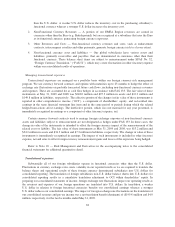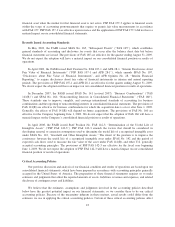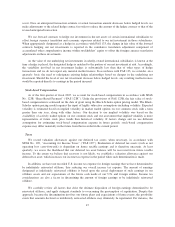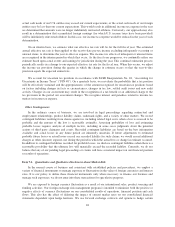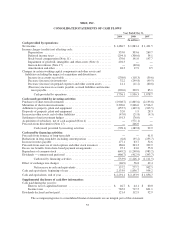Nike 2009 Annual Report Download - page 48
Download and view the complete annual report
Please find page 48 of the 2009 Nike annual report below. You can navigate through the pages in the report by either clicking on the pages listed below, or by using the keyword search tool below to find specific information within the annual report.Goodwill and Indefinite-Lived Intangible Assets
In accordance with SFAS No. 142 “Goodwill and Other Intangible Assets” (“FAS 142”), we perform annual
impairment tests on goodwill and intangible assets with indefinite lives in the fourth quarter of each fiscal year,
or when events occur or circumstances change that would, more likely than not, reduce the fair value of a
reporting unit or an intangible asset with an indefinite life below its carrying value. Events or changes in
circumstances that may trigger interim impairment reviews include significant changes in business climate,
operating results, planned investments in the reporting unit, or an expectation that the carrying amount may not
be recoverable, among other factors. The impairment test requires us to estimate the fair value of our reporting
units. If the carrying value of a reporting unit exceeds its fair value, the goodwill of that reporting unit is
potentially impaired and we proceed to step two of the impairment analysis. In step two of the analysis, we
measure and record an impairment loss equal to the excess of the carrying value of the reporting unit’s goodwill
over its implied fair value should such a circumstance arise.
We generally base our measurement of the fair value of a reporting unit on a blended analysis of the present
value of future discounted cash flows and the market valuation approach. The discounted cash flows model
indicates the fair value of the reporting unit based on the present value of the cash flows that we expect the
reporting unit to generate in the future. Our significant estimates in the discounted cash flows model include: our
weighted average cost of capital; long-term rate of growth and profitability of the reporting unit’s business; and
working capital effects. The market valuation approach indicates the fair value of the business based on a
comparison of the reporting unit to comparable publicly traded firms in similar lines of business. Significant
estimates in the market valuation approach model include identifying similar companies with comparable
business factors such as size, growth, profitability, risk and return on investment and assessing comparable
revenue and operating income multiples in estimating the fair value of the reporting unit.
We believe the weighted use of discounted cash flows and the market valuation approach is the best method
for determining the fair value of our reporting units because these are the most common valuation methodologies
used within our industry; and the blended use of both models compensates for the inherent risks associated with
either model if used on a stand-alone basis.
Indefinite-lived intangible assets primarily consist of acquired trade names and trademarks. In measuring the
fair value for these intangible assets, we utilize the relief-from-royalty method. This method assumes that trade
names and trademarks have value to the extent that their owner is relieved of the obligation to pay royalties for
the benefits received from them. This method requires us to estimate the future revenue for the related brands, the
appropriate royalty rate and the weighted average cost of capital.
Hedge Accounting for Derivatives
We use forward exchange contracts and option contracts to hedge certain anticipated foreign currency
exchange transactions, as well as any resulting receivable or payable balance. When specific criteria required by
SFAS No. 133, “Accounting for Derivative and Hedging Activities,” as amended and interpreted (“FAS 133”),
have been met, changes in fair values of hedge contracts relating to anticipated transactions are recorded in other
comprehensive income rather than net income until the underlying hedged transaction affects net income. In most
cases, this results in gains and losses on hedge derivatives being released from other comprehensive income into
net income some time after the maturity of the derivative. One of the criteria for this accounting treatment is that
the forward exchange contract amount should not be in excess of specifically identified anticipated transactions.
By their very nature, our estimates of anticipated transactions may fluctuate over time and may ultimately vary
from actual transactions. When anticipated transaction estimates or actual transaction amounts decrease below
hedged levels, or when the timing of transactions changes beyond the threshold allowed by FAS 133, we are
required to reclassify at least a portion of the cumulative changes in fair values of the related hedge contracts
from other comprehensive income to other (income) expense, net during the quarter in which such changes
46




